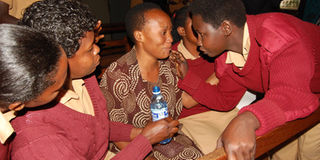Prime
How Draru escaped hanging

Draru (C) is consoled by prison wardresses at the High Court on Thursday after she was handed a 14-year jail sentence. PHOTO BY STEPHEN OTAGE
What you need to know:
The sentence. Draru was on Thursday sentenced to 14 years in prison by the Kampala High Court Justice Monica Mugenyi.
Lydia Draru, who confessed to killing former army commander Maj. Gen. James Kazini, had earlier been arraigned for murder whose maximum penalty is death by hanging, but on Thursday she survived the noose, due to prosecution’s loopholes that were never filled during the trial though convicted of manslaughter, a lesser offense of killing a person unintentionally.
Saturday Monitor brings you some of the loopholes.
1. How Kazini sustained the deep injuries
The medical evidence adduced by the prosecution failed to establish the actual cause of the deep cut wounds found on Kazini’s head as there were different accounts to that which was resolved in Draru’s favour.
During the trial, Draru’s niece Toboru, told court that her aunt hit the deceased once on the back, and once again on the head. This account was similar to Draru’s, who said she hit the deceased once on the back and, when he turned, hit him on the head. The pathologist in his testimony stated that each of the deceased’s injuries represented a blow and the deceased could have received a total of 5 blows to the head.
In her defence, Draru told court that the deep cuts to the deceased’s head could be attributed to his falling down on pieces of broken glass that was strewn on the sitting room during the brawl. Her testimony corroborated with the testimony of her niece and the scene of crimes officer. The prosecution failed to present any evidence that proved whether the deep cuts observed were directly caused by repeated blows to the deceased’s head so as to impute malice aforethought on her part. According to the judge the probability of the hollow metallic found at the scene of crime for causing the deep cut wounds on Kazini’s head that led to his death was remote.
2. Faulty forensic expert evidence
The prosecution failed to prove that blood droplets on a green blouse recovered at the scene of crime, belonged to Draru. Draru rebutted this evidence when she stated that as soon as she got home after a night out with Maj. Gen. Kazini, she changed the clothes and wore a black and white T-shirt. Her evidence was corroborated by her niece’s testimony who testified that she wore a black blouse with white writings on it at the time she committed the offence.
According to the judge, at the time the crime was committed, Draru was dressed in a black but not a green T-shirt as stated by prosecution. And this piece of evidence casts doubt on forensic expert’s explanation that the blood stains found on the green T-shirt were caused by Draru hitting a bleeding Kazini.
Turning to the pair of dark blue jeans recovered at the scene of crime, the forensic expert in his account to court said the pattern of 5 blood droplets at the front of the jeans suggested that the wearer thereof was standing offside and not in front of a gushing artery. The judge held that this evidence does not prove that Draru hit the bleeding person, neither was it proved that she wore blue jeans.
3. Testimony of Draru’s neighbour Tereza Irawo
There were also loopholes in the testimony of Draru’s neighbour, Tereza Irawo, who testified that at about 6am on the fateful day, as she prepared to start her morning prayers she heard three loud bangs coming from the direction of Draru’s house across the road from her house. She did not see what exactly caused them. The bangs heard by Ms Irawo were speculated to be among others, further beatings by Draru ; sounds of Kazini falling repeatedly, suggesting that after the initial blows he got up but was hit repeatedly.
4. Draru’s conduct.
Having found that the manner in which the lethal weapon was used was not proven to connote malice aforethought, the judge now addressed her mind on the conduct of Draru, before, during and after the murder was committed.
During the trial, the testimonies of both Draru and her niece stated that Kazini assaulted her aunt but she did not retaliate. Draru reaffirmed to her earlier confession to killing Gen. Kazini and making calls to the area Chairman and her sister, informing them of the deceased’s death. Throughout her trial, Draru also maintained she was guilty. Such conduct according to the Judge does not commensurate malice aforethought inherent in an indictment of murder.
5.Mysterious pistol
The prosecution in their case did not mention the existence of a fully loaded pistol recovered in Kazini’s car that was parked outside Draru’s home on the fateful day; yet he had drawn the same pistol at Draru threatening to kill her after accusing her of theft and infidelity. The judge noted in her judgment that Draru was very well aware that Kazini was armed and acted in the best way she could though used excessive force.
[email protected]




